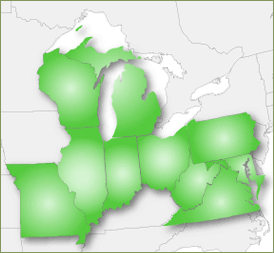This Web site is part of a multistate effort in Michigan, Illinois, Indiana, Maryland, Ohio, Pennsylvania,
and Wisconsin to bring you the latest information about emerald ash borer.

Emerald Ash Borer
Emerald ash borer (EAB), Agrilus planipennis Fairmaire, is an exotic beetle that was discovered in southeastern Michigan near Detroit in the summer of 2002. The adult beetles nibble on ash foliage but cause little damage. The larvae (the immature stage) feed on the inner bark of ash trees, disrupting the tree's ability to transport water and nutrients. Emerald ash borer probably arrived in the United States on solid wood packing material carried in cargo ships or airplanes originating in its native Asia. Emerald ash borer is also established in Windsor, Ontario, was found in Ohio in 2003, northern Indiana in 2004, northern Illinois and Maryland in 2006, western Pennsylvania and West Virginia in 2007, and Wisconsin, Missouri and Virginia in summer 2008. Since its discovery, EAB has:
- Killed tens of millions of ash trees in southeastern Michigan alone, with tens of millions more lost in Ohio, Illinois, Indiana, Pennsylvania, West Virginia, Missouri, Wisconsin, Virginia, Ontario, and Quebec.
- Caused regulatory agencies and the USDA to enforce quarantines (Michigan, Illinois, Indiana, Maryland, Missouri, Ohio, Ontario, Pennsylvania, Quebec, Virginia, West Virginia, and Wisconsin) and fines to prevent potentially infested ash trees, logs or hardwood firewood from moving out of areas where EAB occurs.
- Cost municipalities, property owners, nursery operators and forest products industries tens of millions of dollars.
THE EMERALD ASH BORER COST CALCULATOR
Purdue University entomologist Cliff Sadof has developed a calculator for urban foresters &anp; arborists that can help estimate out-of-pocket expenses associated with a particular management strategy over a 25-year period for a community's trees.
The calculator can be used to compare costs of management strategies that include mixtures of tree removal, replacement, and insecticide treatment over a 25-year period.
Check out the calculator at http://extension.entm.purdue.edu/treecomputer/index.php, and refer any questions or comments to Dr. Sadof at csadof@purdue.edu.
What's Being Done:
A concerted effort to stop EAB has been launched by state and federal officials.
- Research is being conducted at universities, as well, to understand the beetle's life cycle and find ways to detect new infestations, control EAB adults and larvae, and contain the infestation.
- Quarantines are in place to prevent infested ash firewood, logs or nursery trees from being transported and starting new infestations.
This Web site provides information from Michigan State University, Purdue University, the Ohio State University, the Michigan and Ohio departments of Agriculture; the Michigan, Indiana and Ohio departments of Natural Resources; the USDA Forest Service; the USDA Animal and Plant Health Inspection Service (APHIS); and the Canadian Food Inspection Agency. Our goal is to help you find answers to your questions about EAB. We also provide links to other EAB-related Web sites. Please check this site often because information changes frequently.
What to know about EAB:
- It attacks only ash trees (Fraxinus spp.).
- Adult Beetles are metallic green and about 1/2-inch long.
- Adults leave a D-shaped exit hole in the bark when they emerge in spring.
- Woodpeckers like EAB larvae; heavy woodpecker damage on ash trees may be a sign of infestation.
- Firewood cannot be moved in many areas of Michigan, Ohio, Illinois, Indiana, Pennsylvania, West Virginia, Maryland, Ontario and Quebec because of the EAB quarantine (Michigan, Illinois, Indiana, Maryland, Missouri, Ohio, Ontario, Pennsylvania, Virginia, West Virginia, and Wisconsin)
- It probably came from Asia in wood packing material.
If you suspect you may have EAB in your ash trees, call these numbers:
- Michigan — 1-866-325-0023
- Illinois — Contact your county Extension office. The Illinois Department of Agriculture also will offer a toll-free hotline at 1-800-641-3934 for extension-confirmed infestations
- Indiana — 1-866-NO-EXOTIC
- Iowa — 1-515-294-5963
- Kentucky — 1-859-257-5838
- Maryland — University of Maryland Home and Garden Information Center — 1-800-342-2507 or the Maryland Department of Agriculture — 1-410-841-5920
- Minnesota — 1-888-545-6684 (Arrest-the-Pest Hotline)
- Missouri — 1-866-716-9974
- Ohio — 1-888-OHIO-EAB
- Pennsylvania — 1-866-253-7189
- Virginia — The Forest Pest Branch of Fairfax County at 703-324-5304, the Arlington Office of Virginia Cooperative Extension at 703-228-6423 or 703-228-6400, or the Virginia Department of Agriculture and Consumer Services at 804-786-3515
- West Virginia — 1-304-256-6742
- Wisconsin — 1-800-462-2803
- USDA APHIS — 1-866-322-4512
- Canada — 1-866-463-6017
Scientists are studying methods of controlling EAB. The latest information on insecticide evaluations can help homeowners, arborists and landscapers decide if and how they can treat trees for EAB in certain areas in southeastern Michigan.
IMPORTANT NOTE: Using insecticides to control EAB on ash trees is an option in Michigan and the EAB quarantined counties in Ohio, Indiana and Illinois. If your tree is located within an area designated for eradication or suppression activities, it may be removed by regulatory agencies even if it has been treated. In those cases where government-ordered tree removals occur within the contiguous EAB quarantine counties, consideration will be given to ash trees treated by certified applicators utilizing methods and materials recommended by Michigan State University. If your ash trees are located outside of this area in Michigan, Indiana, Illinois or Ohio, using insecticides may not be recommended. If you are not sure about the regulatory status of your area or whether you should consider insecticides, please contact your county Extension office.
